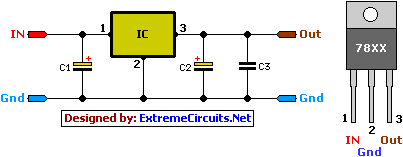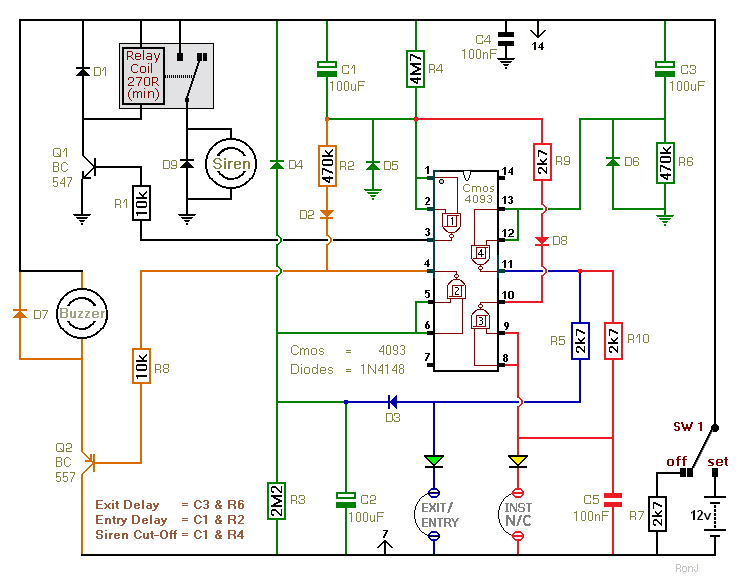
HEADS OR TAILS GAME CIRCUIT

This circuit is designed to electronically simulate the tossing of a coin using a 4049 hex inverter integrated circuit (IC). It employs two of these ICs, specifically IC1a and IC1b, which are configured as an astable oscillator. This configuration causes two LEDs, D1 and D2, to alternate rapidly at a frequency that is imperceptible to the human eye, making both LEDs appear to be continuously illuminated. When the SPIN switch S2 is closed, the display freezes, and the LED that was lit at the moment the switch was activated remains illuminated. Reopening the switch resumes the oscillation. The circuit provides an equal probability for either LED to light up, making it suitable for use in board games to determine which player will take the first turn.
The electronic schematic for the coin toss simulator features a 4049 hex inverter IC, which consists of six independent inverters. In this design, two of the inverters (IC1a and IC1b) are employed in an astable multivibrator configuration. The astable operation is achieved by connecting resistors and capacitors to the input and feedback paths of the inverters, allowing for continuous oscillation.
The frequency of oscillation can be adjusted by varying the resistor and capacitor values in the circuit. This configuration results in a square wave output that drives the two LEDs, D1 and D2, connected to the outputs of IC1a and IC1b, respectively. The rapid switching of the outputs creates the illusion of both LEDs being lit simultaneously.
The SPIN switch S2 is a momentary push-button switch that, when pressed, interrupts the oscillation and latches the state of the LEDs. The LED that is lit at the moment of switch activation will remain on, simulating the result of a coin toss. Releasing the switch reconnects the circuit, allowing the astable oscillator to resume operation, thus reinitiating the alternating LED display.
To ensure reliable operation, bypass capacitors may be added to the power supply pins of the IC to filter out any noise. Additionally, current-limiting resistors should be included in series with the LEDs to prevent excessive current flow, which could damage the components. The circuit can be powered using a standard DC power supply or batteries, making it versatile for various applications, including board games and decision-making scenarios. Overall, this simple yet effective circuit provides a fun and engaging way to introduce randomness in gameplay.Designed to simulate by electronic means thetossing of a coin, the circuit is based upon a 4049 hex inverter IC, two of which are used. IC1a andIC1b are wired as an astable oscillator, which causes two LEDs D1 and D2 ‰ to alternate rapidly, at a frequency too high to be distinguished by thenaked eye.
Both LEDs, therefore, appear to be constantly illuminated. when the SPIN switch S2 is closed, this has the effect of freezing the display, and the LED, which was illuminated at the instantthat the switch was closed, will now be continuously alight. Opening the switch enables the oscillator once more. There is an equal chance of either LED lighting, and the circuit can be used in boardgames, for example, to choose which player will move first.
🔗 External reference
The electronic schematic for the coin toss simulator features a 4049 hex inverter IC, which consists of six independent inverters. In this design, two of the inverters (IC1a and IC1b) are employed in an astable multivibrator configuration. The astable operation is achieved by connecting resistors and capacitors to the input and feedback paths of the inverters, allowing for continuous oscillation.
The frequency of oscillation can be adjusted by varying the resistor and capacitor values in the circuit. This configuration results in a square wave output that drives the two LEDs, D1 and D2, connected to the outputs of IC1a and IC1b, respectively. The rapid switching of the outputs creates the illusion of both LEDs being lit simultaneously.
The SPIN switch S2 is a momentary push-button switch that, when pressed, interrupts the oscillation and latches the state of the LEDs. The LED that is lit at the moment of switch activation will remain on, simulating the result of a coin toss. Releasing the switch reconnects the circuit, allowing the astable oscillator to resume operation, thus reinitiating the alternating LED display.
To ensure reliable operation, bypass capacitors may be added to the power supply pins of the IC to filter out any noise. Additionally, current-limiting resistors should be included in series with the LEDs to prevent excessive current flow, which could damage the components. The circuit can be powered using a standard DC power supply or batteries, making it versatile for various applications, including board games and decision-making scenarios. Overall, this simple yet effective circuit provides a fun and engaging way to introduce randomness in gameplay.Designed to simulate by electronic means thetossing of a coin, the circuit is based upon a 4049 hex inverter IC, two of which are used. IC1a andIC1b are wired as an astable oscillator, which causes two LEDs D1 and D2 ‰ to alternate rapidly, at a frequency too high to be distinguished by thenaked eye.
Both LEDs, therefore, appear to be constantly illuminated. when the SPIN switch S2 is closed, this has the effect of freezing the display, and the LED, which was illuminated at the instantthat the switch was closed, will now be continuously alight. Opening the switch enables the oscillator once more. There is an equal chance of either LED lighting, and the circuit can be used in boardgames, for example, to choose which player will move first.
🔗 External reference





